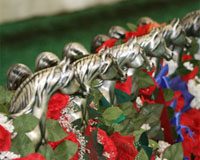Use this exercise to teach your horse to confidently cross and jump over a variety of natural and man-made obstacles. Giving your horse a purpose will make training sessions more fun and exciting for both of you and will challenge the horse’s respect and trust in you. Drilling on the same exercises the same way every day is what causes a lot of horses to become pinny-eared and sour. When you introduce obstacles, your horse’s attitude will pick up considerably.

1. Before sending the horse over or through any obstacle, always get him used to the obstacle by sending him between you and it on as many sides of it as you can. It’s a little test: If you can’t get your horse to go between you and the object, you’re never going to get him to go over it or through it. Stand about 10 feet away from the barrels, and send the horse between you and the obstacle, keeping your feet still. Yield his hindquarters and have him turn to face you. Then send him between you and the barrels again. Practice this until the horse is comfortable walking or trotting between you and the barrels. Do this on all three sides of the barrels.

2. Stand at the end of barrel closest to the middle of the arena to block the horse from trying to run out the side. Then, using Approach and Retreat, send the horse between the barrels. At first, when you send the horse up to the barrels, he’ll probably stop and try to back away from them because he’s unsure of the situation. The trick is to stop him before he wants to stop. That way, stopping is always your idea. If you think he’s going to stop in nine steps, stop him in eight steps. Then back him away from the barrels. Ask him to go forward toward the barrels again, and before he stops, back him away. Each time you send him forward toward the barrels, try to get him to come a little closer to them.
SUCCESS TIP: If your horse wants to smell or investigate the obstacle, let him. Horses sometimes need to perform their own safety check of an object before they’re comfortable with it.

3. As the horse gets comfortable going between the gap, gradually push the barrels closer together, making the gap smaller. Eventually, he’ll have no choice but to jump over the barrels. You’ll know the horse is comfortable going through the gap when you can point with the lead rope and he’ll come forward without hesitation and calmly walk or trot through.
4. Don’t act like a predator. If the horse comes up to the barrels, hesitates and is leaning forward, right on the verge of going over, do the opposite of what you’d like to do (put more pressure on him) and instead back him away. Don’t try to force him over, just wait for him to find the answer. The timing of when you apply pressure is critical. Never pressure the horse when he is investigating the obstacle or thinking about going over it. Instead, if your horse is reluctant to go over the barrels, apply pressure with the stick and string when he’s away from them. That’ll create energy in his feet so that his momentum will carry him over the barrels.
5. Once the horse is jumping the barrels, keep him lunging a circle in one direction. Let him get comfortable jumping the barrels on one side before you ask him to do it on the other side.
If your horse hasn’t jumped before, don’t be surprised if he over exaggerates the jump. Once he’s comfortable with the obstacle, he’ll realize that he doesn’t need to jump 4 feet in the air to clear it. It’s common for horses to get excited when you ask them to do something new. Your horse might pull on the lead rope a little bit and run around the circle fast; just give him a chance to relax and settle down.

6. When your horse is confident jumping the barrels from either direction, send him back and forth over the barrels. You can make the barrels spookier by laying a tarp over the top of them, painting them, etc. The greatest asset you have in training horses is your imagination. The more creative you can be in your training, the better your horse will perform and the more he will enjoy his work.
Clinician Clinton Anderson owns and operates Downunder Horsemanship in Stephenville, Texas. www.downunderhorsemanship.com
This article originally appeared in the August 2015 issue of Horse Illustrated magazine. Click here to subscribe!





